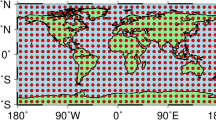Abstract
In semi-dynamical satellite geodesy, the satellite orbit is determined beforehand by dynamical methods, and tracking station coordinates are determined geometrically from satellite observations and the accepted satellite coordinates. This paper analyzes the use of the U.S. Navy Navigational Satellite Doppler (formerly Transit) system in the semidynamical mode, presenting some test network numberical results. Three error sources are considered: errors in the satellite coordinates, refractive errors on the Doppler observations, errors contributed by the tracking receivers. Compensatory techniques are discussed, such as relaxing the satellite orbit, ionospheric and tropospheric refraction reductions, tracking receiver time recovery, translocation.
Similar content being viewed by others
References
R.J. Anderle, C.A. Malyevac, and H.L. Green (1969): “Effect of Neglected Gravity Coefficients on Computed Satellite Orbits and Geodetic Parameters”. Journal of Spacecraft and Rockets, 6, No. 8.
R.J. ANDERLE and M.G. TANNENBAUM (1974): “Practical Realization of Reference System for Earth Dynamics by Satellite Methods”. Technical Report 3161, U.S. Naval Weapons Laboratory, Dahlgren, Virginia.
R.J. ANDERLE (1974): “Transformation of Terrestrial Survey Data to Doppler Satellite Datum”. Journal of Geophydcal Research, 79, pp. 5319–5331.
R.J. ANDERLE (1975): “Error Model for Geodetic Positions derived from Doppler Satellite Observations”. NSWC/DL-TR-3368, Naval Surface Weapons Center, Dahlgren, Virginia 22448.
D. BROUWER (1963): “Minor secular and long-period effects” in Proceedings of the first international symposium on the use of artificial satellites for geodesy. North Holland, Amsterdam.
DOD, (1972): “Report of the DOD Geoceiver Test Program”, DMA Report 0001.
C.A. DUNNELL (1967): “TRANET Doppler tracking system”. APL Technical Digest, 6, No. 4, pp. 17–23.
P.J. FELL (1975): “The Use of Standard Weather Values and Refraction Bias Parameters in Orbit Determination”, The Canadian Surveyor, Vol. 29, No. 3, September.
E.M. GAPOSCHKIN (1973): “1973 Smithsonian Standard Earth (III)”. Smithsonian Astrophysical Observatory Special Report 353, Cambridge, Mass.
W.H. GUIER and G.C. WEIFFENBACH (1960): “A satellite Doppler navigation system”. Proceedings of the Institute of Radio Engineers, 48, pp. 507–516.
W.H. GUIER (1965): “satellite gaodesy”. APL TechnicalDigest, 4, No. 3, pp. 2–12.
H.S. HOPFIELD (1969): “Two-quartic tropospheric refractivity profile for correcting satellite data”. Journal of Geophysical Research, 74, pp. 4487–4499.
H.S. HOPFIELD (1971): “Tropospheric effect on electromagnetically measured range: prediction from surface weather data”. Radio Science, 6, pp. 357–357.
H.S. HOPFIELD (1972): “Tropospheric refraction effect= oft satellite range measurements”. APL Technical Digest, 11, No. 4, pp. 11–19.
W.M. KAULA (1966): “Theory of satellite geodesy”, Blaisdell, Toronto.
S.M. KLOSKO and W.B. KRABILL (1974): “C-Band Station Coordinate Determination for GEOS-C Altimeter Calibration Area”. Bulletin Géodésique, No. 114.
J. KOUBA (1974): “Reduction of Doppler Satellite Data Observed in Canada”, The Canadian Surveyor, 28
J. KOUBA, A.E. PETERSON and J.D. BOAL (1974): “Recent Experience in Doppler Satellite Surveying”, presented at 14th International Congress of Surveyors, Washington, September.
J. KOUBA (1975a): “Doppler Levelling”, submitted for publication in The Canadian Surveyor.
J. KOUBA (1975b): “Doppler Satellite Control in Eatabliishlng Geodetic Control Network” presented at Canadian Geophysical Union Annual Meeting, Waterloo, May.
J. KOUBA end J.D. BOAL (1975): “Program GEODOP Documentation”. Geodetic Survey of Canada.
J.B. MOFFET (1973): “Program Requlrernent= for the Two-Minute Integrated Doppler Satellite Navigation”. APL Technical Memorandum TG-819-1 (Ray. 2), The John Hopkins University, Silver Springs, Maryland.
R.R. NEWTON (1967): “The Navy Navigation Satellite System”. Space Research VII, 2, pp. 735–763.
A.E. PETERSON (1974): “Merging of the Canadian Triangulation Network with 1973 Doppler Satellite Date”. The Canadian Surveyor, 28.
M.C. PINCH (1974): “Test Adjustment of the Canadian Triangulation Network”. The Canadian Surveyor, 28.
V.L. PISCANE, B.B. HOLLAND and H.D. BLACK (1973): “Recent (1973) improvements in the navy navigation satellite system”, Navigation, 20, pp. 223–229.
T. SIMS (1972): “The NWL precise ephemeris}”. Technical Reports; TR-2872, U.S. Naval Weapons Laboratory.
T.H. STANSELL (1971): “Transit, the navy navigation eatallite system”. Navigation, 18, pp. 93–109.
A. THORNDIKE (1973): “Notes on time recovery”, personal communication describing the improved time recovery algorithm implemented in receivers built for the Arctic Ice Dynamics Joint Experiment.
A.S. THORNDIKE (1973): “An Integrated system for measuring sea ice motions”. Proceedings of the 1973 IEEE International Conference on Engineering In the Ocean Environment, pp. 490–499.
A.S. THORNDIKE (1974): “Strain calculations using AIDJEX 1972 position date”. Arctic Ice Dynamics Joint Experiment Bulletin 24, University of Washington, Seattle.
P. VANICEK (1971): “Further development and properties of the spectral analysis by least squares”. Astrophysical and Space Sciencer 12, pp. 10–73.
G.C. WEIFFENBACH (1967): “Tropospheric and ionospheric propagation effects on satellite radio Doppler geodesy”, pp. 339–352 in Electromagnetic Distance Measurement, University of Toronto Press.
D.E. WELLS (1972): “Analysis of Transit Antenna Pham Centre Measurements”. Unpublished report.
D.E. WELLS (1974): “Electromagnetic metrology, Hilbert space optimization, and their application to Doppler satellite control”, Ph. D. thesis, (available as Technical Report 29, surveying Engineering Department, University of New Brunswick, Fredericton).
D.E. WELLS end J. KOUBA (1975): “Semi-Dynamical Doppler Satellite Positioning”, Preprint of paper presented at the Special General Ammbly of International Auociation of Geodesy, Grenoble, France, August 18–23.
E.E. WESTERFIELD and G. WORSLEY (1966): “Translocation by navigation satellite”. APL Technical Digest 4, No. 5, 2–10.
Author information
Authors and Affiliations
Rights and permissions
About this article
Cite this article
Kouba, J., Wells, D.E. Semi-dynamical Doppler satellite positioning. Bull. Geodesique 50, 27–42 (1976). https://doi.org/10.1007/BF02521410
Received:
Revised:
Published:
Issue Date:
DOI: https://doi.org/10.1007/BF02521410




